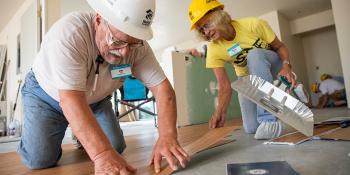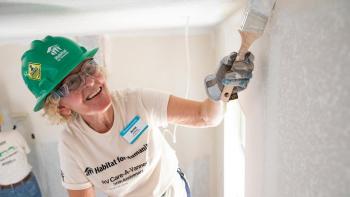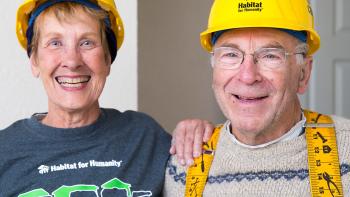
Job site safety for volunteers
At Habitat, we work with our volunteers, homeowners and staff to ensure each build site is a safe working environment.
Your team leader, construction site supervisor and trained Habitat Competent Person have experience reducing hazards, but you as a volunteer can take measures to ensure you and your team’s safety as well.
The RV Care-A-Vanner safety corner provides these tips, which adhere to OSHA guidelines and Habitat best practices, so you can help keep each Habitat job site a safe place to work!
You can also download a PDF of these safety tips for volunteers.
-
Safety begins with a safe attitude. Please keep the following in mind when working on site.
- Think before you begin a task and don’t rush.
- Ask the Habitat Competent Person or team leader if you are unsure how to use a tool or perform a task.
- Avoid distractions and concentrate on the task.
- Inspect all power tools, hand tools, ladders and scaffolding before use.
- Know where the Emergency Action Plan, first-aid kit and fire extinguisher are located.
- Immediately advise the Habitat Competent Person or team leader of any unsafe or hazardous tools or conditions.
-
Dressing in a way that is practical and safe for working on site is important, and loose or inappropriate clothing can be dangerous. Follow these basic guidelines.
- Wear clothes and gloves that fit and are appropriate for the work and weather conditions.
- At the job site, wear work or hiking boots or sturdy shoes that protect from falling objects. Thick, non-slip soles are safest. Any volunteer wearing sandals or other inappropriate footwear will not be permitted to remain on site.
-
Habitat best practice is to wear:
- Hardhats and safety glasses at all times on an active job site.
- Hearing protection whenever exposed to loud or intermittent noise.
- Respiratory protection when inhalation hazards are present.
-
Though you may be enthusiastic to contribute, be sure to volunteer for the tasks you feel you can safely accomplish.
- Lifting. Do not lift beyond your safe lifting ability. Always use the proper lifting technique: bent legs and straight, vertical back. Ask for help.
- Overexertion. Recognize your limits. Avoid struggling to keep up with other team members. When you get tired, take a break; sit down and rest frequently. Habitat building is not a competitive event.
- Hydration. Physical work causes you to perspire, resulting in dehydration. Be sure to replenish your lost liquids. Every job site will have drinking water available.
- Sun. Many job sites are without shade. At the first indication of sunburn, reapply sunscreen and cover exposed areas with clothing.
-
Any tool or equipment including personal protective equipment that you bring to the job site must be inspected and approved by the Habitat Competent Person prior to use.
-
- A qualified person, designated by the Habitat Competent Person, should demonstrate and explain how to properly use power tools before others operate them.
- Report any defective tools to the Habitat Competent Person or team leader so they can be taken out of use.
-
- Never lower or carry a power tool by its cord.
- Extension cords must not be fastened with staples, hung from nails or suspended from wires.
- Do not use an extension cord that has frayed insulation, missing ground pin, exposed wires or a cord end (plug) that is not securely fastened or appears to have burnt prongs.
- Extension cords must be plugged into a circuit protected by a Ground-Fault Circuit Interrupter, which shuts off the power in case of electrical imbalances that could result in an electrical shock.
-
- Nail guns are powerful and dangerous tools. If there are nail guns at the job site, check with the Habitat Competent Person to ensure you’re operating it proficiently and correctly before using it to work.
- Treat a nail gun as you would treat a firearm. The nails can shoot some distance and can be lethal.
- Keep the nail gun tip pointed away from other people. Never aim a nail gun at another person, especially when handing it to someone.
- Be aware that a nail could penetrate your work surface and travel many feet. Ensure no one is working on the other side of what you’re nailing.
- When repositioning yourself with a nail gun, remove your finger from the trigger.
- Know your work surface. Knots in wood have a high possibility of causing a nail ricochet.
- Make sure that the nail gun is set for “full sequential trigger.” This allows only one nail to be released when the trigger and tip are depressed. Nail guns should not be used in “bump fire” mode.
- Keep hands and other body parts away from the nailing point at all times.
- Always disconnect the air hose from the gun to load or do any maintenance to the tool.
-
- Silica, which is a crystalline quartz, is a dangerous carcinogen when inhaled. Silica can be an issue when cutting cementitious products such as cement tile backer or Hardie Board®, when mixing or cutting concrete or mortar or when mixing or dry sanding drywall compounds.
- You can avoid creating dust by using guillotines or specialized shears for siding and trim as well as wet cutting concrete.
- If a saw must be used on cementitious siding or trim, the saw blade must be equipped with an integrated water delivery system or have a dust collection system attached to a High-Efficiency Particulate Air, or HEPA, vacuum. Use respiratory protection when necessary.
- Drywall dust should be removed with a HEPA vac or mixed with an approved sweeping compound prior to sweeping.
-
- Always wear safety glasses or goggles.
- Wear hearing protection if needed.
- No loose clothing or uncontained long hair as both could get caught in the saw blade.
- Make sure the saw you are about to use is not too heavy for you to control.
- The space you’re cutting in should not be cluttered, including on the table, sawhorses or ground.
- The power cord should be clear of your feet so it will not bind while you are cutting.
-
- Check that the depth adjustment and blade guard work properly.
- Avoid binding a saw blade. The blade may bind and kick the saw back toward the operator. Ask for assistance when cutting large pieces of material. Keep both hands on the saw while cutting.
- Never overreach to finish cutting. Stop the saw, reposition yourself or the work and continue.
- Keep your body to the side of your cut, never directly behind.
- Never start the saw when it is touching the material to be cut.
- Always let the saw stop before removing it from the wood, especially if you stop the saw before completing your cut.
-
- Ensure that the blade guard is working properly.
- When working on the blade unplug the cord and place it on the table.
- Secure the saw on a flat, level table.
- Never cross your arms when cutting.
- Know the piece you are cutting.
- Long pieces should be supported at the same height as the miter saw.
- Make sure the piece you are cutting is securely against the saw fence.
- Never cut small pieces that require you to put your fingers near the blade.
-
- Always select the correct type and size of tool for the task, and make sure it is sharp or properly adjusted.
- Do not use a tool if the handle is loose, broken or in poor condition.
- Handle and carry tools with care. Keep sharp-edged and pointed tools turned downward.
- Retract the blade of a razor knife when not in use.
- Carry only a few tools at one time unless they are mounted in a special holder or carried in a tool belt.
- When working with a hammer, wear a hammer loop or tool belt where you can keep the tool when not using it
- Never place tools on a sloping overhead surface, on top of a ladder, scaffolding, wall or in a precarious position where it could fall.
- Never carry sharp tools in your pockets.
- When not in use, tools should be returned to their place of keeping — special boxes, chests or cabinets.
-
Working above ground level on ladders, scaffolding, roofs or floor systems is a common source of accidents at job sites. Injuries of this type may be serious and can be avoided by following safety precautions. Do not work at a height above which you are comfortable.
-
A house roof can be a safe working environment if you wear appropriate footwear, feel comfortable working on the roof or ladder and have adequate fall protection. Use extreme caution and follow a few simple rules:
- Fall protection, such as personal fall arrest systems and/or guardrails with toeboards, should always be used when working on roofs.
- Roof sheathing should not be cut on the roof. It is much safer to send down measurements and have the sheets cut on the ground.
- Always keep track of where you are in relationship to the edge of the roof.
- Avoid laying tools and other items that are not in use on the roof. Unless secured, they will slide down the roof and can hit someone on the ground.
- Secure building materials on the roof to prevent them from sliding or being blown off the roof.
- Some tasks near the edge of the roof are easier and safer if done from a ladder instead of the roof.
- Do not allow scrap materials and sawdust to accumulate on the roof. Sawdust makes the roof sheathing very slippery. Sawdust needs to be swept off periodically.
- Have only as many workers on the roof as is necessary to do the job. More workers on the roof than is efficient can be more of a hindrance than a help.
- Do not work on the roof when the surface is wet.
- Nothing should be thrown off the roof unless the area below has been barricaded and created into a no-access zone.
-
- Inspect a ladder before you use it. Look for loose rungs and defects. If the ladder is unsafe, don’t use it. Habitat job sites should have commercial grade ladders. Household, light duty rated ladders or old ladders with no rating should not be used. They are not designed to take the load and usage of a construction site and can collapse, twist or bend, causing a fall.
- Use a ladder that will reach the work area. An extension ladder should extend 3 feet above the upper level and must be secured against sideways or backwards movement.
- If your belt buckle is extended outside the ladder while you are working, you are overreaching.
- When using an extension ladder, use the 4-to-1 rule. For every 4 feet of height, move the bottom of the ladder 1 foot away from the upper point of contact.
- Place the ladder on solid footing in a safe location. With a step ladder, be sure that all four legs are on the ground and the ladder is fully opened and locked. Never stand on the top step or the top of a step ladder.
- Never use an aluminum ladder in the vicinity of electrical lines.
- Never use a ladder outdoors during inclement weather or on very windy days.
- Always climb a ladder using three points of contact, such as two feet and one hand or two hands and one foot. When climbing, always face the ladder and keep your hands free for climbing. Carry tools and materials in proper carrying devices. Don’t be afraid to ask someone to hold your ladder.
-
- Scaffolding must be erected by qualified persons under the supervision of the Habitat Competent Person.
- The Habitat Competent Person or another qualified person must inspect the scaffold each day before use, after moving or altering the scaffold or following a weather event.
- Scaffolding that is elevated 6 feet or more must be equipped with a guardrail system.
- Scaffolding should always be level, square and plumb, which means exactly vertical.
-
Laying sub-flooring often involves working on floor joists over an open basement or crawl space.
- Look before you step.
- Use fall protection if the work surface is over 6 feet above the lower level.
- Make sure you have secure footing before placing weight on a joist.
- Never step on a board that is not across at least two joists, and then step only in the middle.
- Never step on the free end or ends of an unsecured board that is bridging joists.
-
- Position building materials and supplies in an order that allows adequate aisles and walkways.
- Clean up rubbish and scrap materials as you go, at least twice each day. Do not permit blocks of wood, nails, bolts, empty cans, pipe, wire or other materials to accumulate around the job site where they interfere with the work and constitute a safety and fire hazard.
- Restack unused building materials and serviceable scraps.
- Sweep out the house regularly.
- Remove nails from discarded boards or, at a minimum, bend them over.
- Keep tools and equipment that are not in use in their proper place. This protects both the tools and workers.
- Never leave a job site unattended unless all tools and materials have been properly secured.
- The job site should be cleaned and the tools put away before ending the workday.
-
The local Habitat will discuss emergency procedures with you during the team orientation. If a person is injured on the job, contact your team leader and the Habitat Competent person immediately. They will direct a person to summon medical help, if needed, and obtain the job site first-aid kit.

